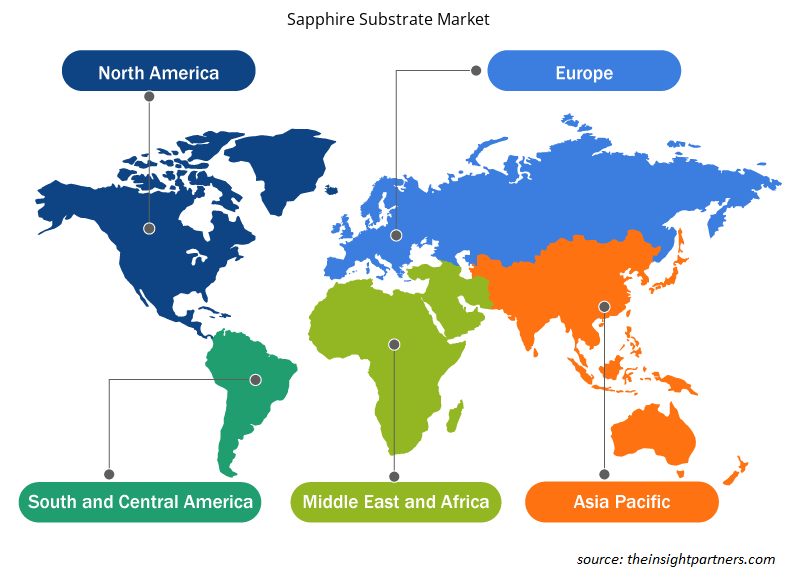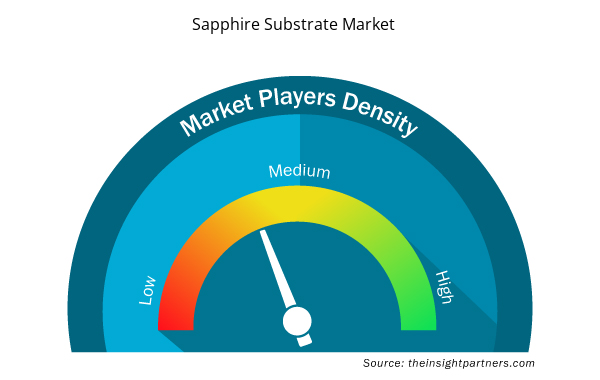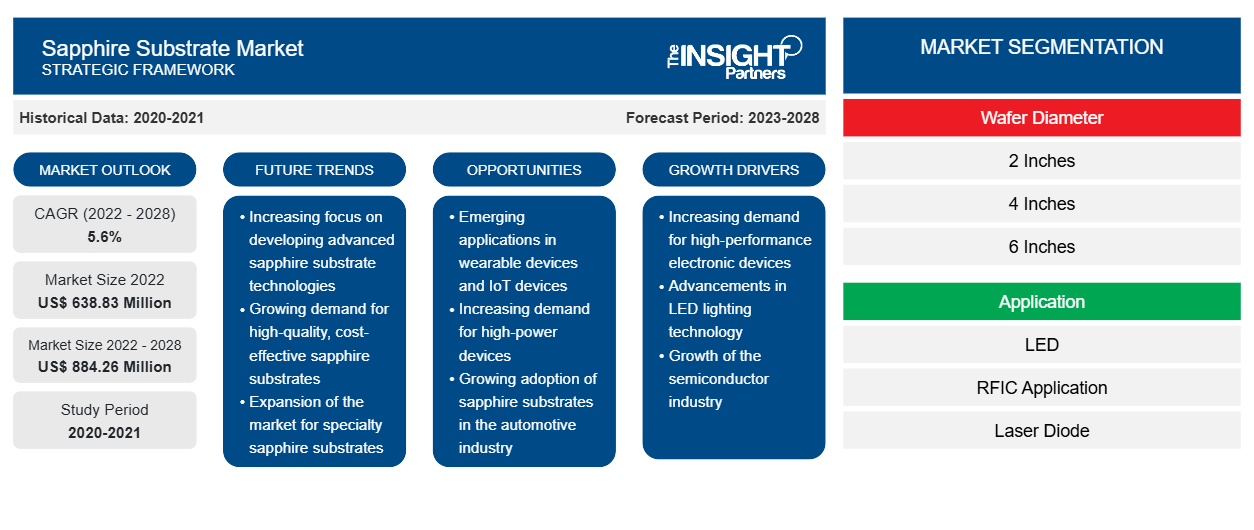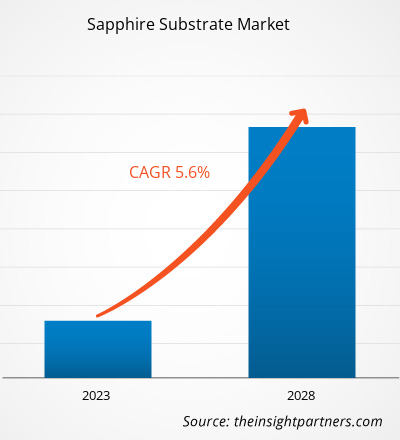Se proyecta que el mercado de sustrato de zafiro alcance los 884,26 millones de dólares estadounidenses en 2028, desde los 638,83 millones de dólares estadounidenses en 2022; se espera que crezca a una CAGR del 5,6 % entre 2022 y 2028.
La electrónica de consumo ofrece enormes oportunidades de crecimiento para el mercado de sustratos de zafiro . Los fabricantes de teléfonos inteligentes y otros productos electrónicos están interesados en utilizar sustratos de zafiro. Con la creciente demanda de productos electrónicos de consumo a nivel mundial, los fabricantes se están centrando en la producción del sustrato de zafiro, que se puede utilizar en la electrónica de consumo. Los actores del mercado de sustratos de zafiro también se están centrando en el desarrollo de obleas de zafiro incoloras para LED, ya que las obleas de zafiro coloreadas tienen efectos negativos. Por ejemplo, en abril de 2022, investigadores de Arabia Saudita desarrollaron grafeno monocristalino mediante el aislamiento de sustratos a escala de oblea. Los investigadores consideran que este desarrollo es importante porque el efecto de campo que los transistores producidos a partir de una monocapa de grafeno monocristalino cultivado en zafiro funcionaron de manera excelente.
En los últimos tiempos, la demanda de zafiro incoloro de alta calidad ha aumentado por parte de los fabricantes de LED para controlar los costos y mejorar la calidad del producto. Por lo tanto, se espera que la adopción de sustrato de zafiro incoloro traiga nuevas oportunidades para el crecimiento del mercado de sustrato de zafiro durante el período de pronóstico. Además, debido al aumento de las actividades mineras de grandes cristales en varios países, el nivel de producción de zafiro también aumentará. El zafiro se integrará con los procesos de fabricación de semiconductores existentes, lo que dará como resultado una reducción general de costos para el sustrato de zafiro.
Personalice este informe según sus necesidades
Obtendrá personalización en cualquier informe, sin cargo, incluidas partes de este informe o análisis a nivel de país, paquete de datos de Excel, así como también grandes ofertas y descuentos para empresas emergentes y universidades.
- Obtenga las principales tendencias clave del mercado de este informe.Esta muestra GRATUITA incluirá análisis de datos, desde tendencias del mercado hasta estimaciones y pronósticos.
Impacto de la pandemia de COVID-19 en el tamaño del mercado de sustratos de zafiro
La pandemia de COVID-19 ha afectado negativamente de manera significativa a Europa, lo que indica que el presupuesto de semiconductores y electrónica de la región puede verse afectado considerablemente mientras las economías de Europa se recuperan del brote. Dado que el brote de COVID-19 afectó gravemente a los presupuestos generales, muchos países europeos redujeron su gasto en electrónica y semiconductores. Se prevé que el impacto positivo en los programas de adquisiciones y las actividades de investigación y desarrollo (I+D) afecte significativamente al mercado de sustratos de zafiro en Europa en los próximos años. Se prevé que el sector de la electrónica de consumo en la Unión Europea experimente la caída más pronunciada de la demanda y una brecha de rendimiento más amplia a lo largo del tiempo debido a los patrones cambiantes de demanda, los cierres de empresas, el desempleo y las caídas sin precedentes del producto interno bruto (PIB) en muchos países. Se prevé que el sector regional de la automoción y el transporte crezca a medida que los gobiernos ofrezcan incentivos a los compradores de automóviles en los próximos años.sizeable hit while Europe’s economies recover from the outbreak. Since the COVID-19 outbreak severely impacted overall budgets, many European countries reduced their electronics and semiconductor expenditure. The positive impact on the procurement programs and research & development (R&D) activities is anticipated to significantly affect the sapphire substrate market in Europe in the coming years. The
Las importantes iniciativas de los gobiernos y los principales actores del mercado están permitiendo que el mercado de sustratos de zafiro de la UE se recupere de los efectos adversos de la pandemia de COVID-19. La UE busca lanzarse a la primera división mundial de fabricación de semiconductores para 2030. Intel tiene como objetivo construir una fábrica de semiconductores de 20 mil millones de dólares. Europa se ha establecido significativamente en la cadena de suministro de la industria de semiconductores. Sin embargo, está muy por detrás de Asia en la fabricación de obleas de gama alta. Por lo tanto, los gobiernos del Reino Unido, Alemania y Francia están realizando importantes inversiones en la tecnología de semiconductores y centrándose en asociaciones y colaboraciones para impulsar el mercado regional. Se prevé que el establecimiento de centros de producción clave en la UE y la Asociación Europea de Libre Comercio (AELC), que incluyen a Austria, Francia, Alemania, Italia, Irlanda y los Países Bajos, todos estos países que albergan a varios fabricantes líderes, impulse el crecimiento del mercado de sustratos de zafiro de Europa.EU’s sapphire substrate market to recover from the adverse effects of the COVID-19 pandemic. The EU is seeking to launch itself into the global premier league of semiconductor manufacturing by 2030. Intel aims to build a US$ 20 billion semiconductor factory. Europe has established itself significantly in the semiconductor industry supply chain. However, it lags far behind Asia in the manufacturing of highest-end wafers. Thus, the governments of the UK, Germany, and France are making significant investments in the semiconductor technology and focusing on partnerships and collaborations to boost the regional market. The establishments of key production centers in the EU and European Free Trade Association (EFTA) that include Austria, France, Germany, Italy, Ireland, and the Netherlands, all of these countries are home to several leading manufacturers is projected to boost the Europe’s sapphire substrate market growth.
Perspectivas de mercado: mercado de sustrato de zafiro
El mercado de sustratos de zafiro estuvo dominado por la región APAC, seguida de América del Norte, Europa, Oriente Medio y África, y América del Sur y Central. Las "cuatro grandes" áreas de semiconductores (Corea del Sur, Japón, China y Taiwán) han desempeñado un papel clave en el crecimiento ascendente, intermedio y descendente de la industria de semiconductores, incluso a nivel mundial. Para competir y prosperar en un entorno tan altamente competitivo, las naciones de Asia Pacífico acelerarán la velocidad de la I+D y la innovación en el negocio de los semiconductores a medida que crezca la demanda de semiconductores y aumenten los estándares de diversidad. Como resultado, Asia Pacífico se convertirá en la columna vertebral de la industria mundial de semiconductores. Por ejemplo, en agosto de 2020, Monocrystal, un actor clave en el cultivo y procesamiento de zafiro sintético, inició un proyecto destinado a fabricar obleas de zafiro de diámetro extragrande para aplicaciones disruptivas de diodos emisores de luz (LED). La Comisión Intergubernamental Ruso-China lo aprobó en materia de cooperación en materia de inversiones. Estos factores promoverán un tremendo crecimiento en la región y harán de Asia Pacífico una región importante para el tamaño del mercado de sustratos de zafiro durante el período de pronóstico.APAC, followed by North America, Europe, Middle East & Africa, and South & Central America. The "Big Four" semiconductor areas—South Korea, Japan, China, and Taiwan—have played a key role in the semiconductor industry's upstream, midstream, and downstream growth, even globally. To compete and flourish in such a highly competitive environment, Asia Pacific nations will accelerate the speed of R&D and innovation in the semiconductor business as demand for semiconductors grows and diversity standards rise. As a result, Asia Pacific will become the global semiconductor industry's backbone. For instance, in August 2020, Monocrystal—a key player in synthetic sapphire growing and processing—started a project aiming to manufacture extra-large diameter sapphire wafers for disruptive
Perspectivas basadas en aplicaciones
El mercado de sustratos de zafiro, por aplicación, está segmentado en LED, aplicación RFIC, diodo láser y silicio sobre zafiro (SOS) IC, y otros. Los sustratos de zafiro se utilizan en la producción de silicio sobre obleas para producir aplicaciones de circuitos integrados de radiofrecuencia (RFIC) de alto rendimiento. El uso de sustratos de zafiro es alto en LED, ya que tiene un buen aislamiento eléctrico y resistencia a altas temperaturas. El segmento LED lideró la participación de mercado de sustratos de zafiro en 2021.RFIC Application, Laser Diode, and Silicon on Sapphire (SOS) IC, and Others. Sapphire substrates are used in the production of silicon-on-wafers to produce high performance radio frequency integrated circuit (RFIC) application. The use of sapphire substrates is high in LED as it has good electrical insulation and high temperature resistance. The LED segment led the sapphire substrate market share in 2021.
El mercado de sustratos de zafiro está segmentado en función del diámetro de la oblea, la aplicación y la geografía. Según el diámetro de la oblea, el mercado se segmenta en 2 pulgadas, 4 pulgadas, 6 pulgadas y otros. Según la aplicación, el mercado se segmenta en LED, RFIC, diodo láser y silicio sobre zafiro (SOS) IC y otros. Según la geografía, el mercado de sustratos de zafiro se segmenta principalmente en América del Norte, Europa, Asia Pacífico (APAC), Oriente Medio y África (MEA) y América del Sur y Central.RFIC, laser diode, and silicon on sapphire (SOS) IC and others. Based on geography, the sapphire substrate market is primarily segmented into North America, Europe, Asia Pacific (APAC), the Middle East & Africa (MEA), and South and Central America.
Perspectivas regionales del mercado de sustrato de zafiro
Los analistas de Insight Partners explicaron en detalle las tendencias y los factores regionales que influyen en el mercado de sustratos de zafiro durante el período de pronóstico. Esta sección también analiza los segmentos y la geografía del mercado de sustratos de zafiro en América del Norte, Europa, Asia Pacífico, Oriente Medio y África, y América del Sur y Central.

- Obtenga datos regionales específicos para el mercado de sustrato de zafiro
Alcance del informe sobre el mercado de sustratos de zafiro
| Atributo del informe | Detalles |
|---|---|
| Tamaño del mercado en 2022 | US$ 638,83 millones |
| Tamaño del mercado en 2028 | US$ 884,26 millones |
| CAGR global (2022-2028) | 5,6% |
| Datos históricos | 2020-2021 |
| Período de pronóstico | 2023-2028 |
| Segmentos cubiertos | Por diámetro de oblea
|
| Regiones y países cubiertos | América del norte
|
| Líderes del mercado y perfiles de empresas clave |
|
Densidad de actores del mercado de sustrato de zafiro: comprensión de su impacto en la dinámica empresarial
El mercado de sustratos de zafiro está creciendo rápidamente, impulsado por la creciente demanda de los usuarios finales debido a factores como la evolución de las preferencias de los consumidores, los avances tecnológicos y una mayor conciencia de los beneficios del producto. A medida que aumenta la demanda, las empresas amplían sus ofertas, innovan para satisfacer las necesidades de los consumidores y aprovechan las tendencias emergentes, lo que impulsa aún más el crecimiento del mercado.
La densidad de actores del mercado se refiere a la distribución de las empresas o firmas que operan dentro de un mercado o industria en particular. Indica cuántos competidores (actores del mercado) están presentes en un espacio de mercado determinado en relación con su tamaño o valor total de mercado.
Las principales empresas que operan en el mercado de sustrato de zafiro son:
- Compañía de visualización Iljin Ltd.
- Corporación Kyocera
- Óptica Meller, Inc.
- Monocristal
- Tecnología Rubicon Inc.
Descargo de responsabilidad : Las empresas enumeradas anteriormente no están clasificadas en ningún orden particular.

- Obtenga una descripción general de los principales actores clave del mercado de sustrato de zafiro
Entre los actores clave del mercado de sustratos de zafiro se encuentran Saint-Gobain Group; KYOCERA Corporation; Semiconductor Wafer, Inc.; Precision Micro-Optics, Inc.; y Crystalwise Technology, Inc.
Los actores que operan en el estudio del mercado del sustrato de zafiro se centran principalmente en el desarrollo de productos avanzados y eficientes.
- En 2022, Meller Optics, Inc. presentó una gama completa de pequeñas bolas de zafiro y rubí de alta precisión para usar en instrumentos, equipos de medición y otros mecanismos de precisión que requieren cojinetes de baja fricción, vida útil prolongada y precisión dimensional.
- En 2021, Meller Optics, Inc. lanzó ventanas y cúpulas de zafiro hechas a medida, adecuadas para proteger cámaras, detectores y sensores en drones militares y comerciales diseñados para su uso en entornos severos.
- Análisis histórico (2 años), año base, pronóstico (7 años) con CAGR
- Análisis PEST y FODA
- Tamaño del mercado Valor/volumen: global, regional, nacional
- Industria y panorama competitivo
- Conjunto de datos de Excel


- Equipment Rental Software Market
- Volumetric Video Market
- Fishing Equipment Market
- Trade Promotion Management Software Market
- Collagen Peptides Market
- Semiconductor Metrology and Inspection Market
- Smart Mining Market
- Single-Use Negative Pressure Wound Therapy Devices Market
- Railway Braking System Market
- Nurse Call Systems Market

Report Coverage
Revenue forecast, Company Analysis, Industry landscape, Growth factors, and Trends

Segment Covered
This text is related
to segments covered.

Regional Scope
North America, Europe, Asia Pacific, Middle East & Africa, South & Central America

Country Scope
This text is related
to country scope.
Preguntas frecuentes
By 2028, the global market size of sapphire substrate market will be USD 884.26 Million.
Mexico, Russia, Germany, India, South Korea, Saudi Arabia are registering a high growth rate during the forecast period.
LED segment held the largest share in sapphire substrate market. The sapphire substrates are mostly used in producing light-emitting diodes (LEDs) due to 3 major reasons: Mechanical strength, flatness, and light transmission.
China holds the major market share of sapphire substrate market in 2022.
Saint-Gobain Group, KYOCERA Corporation, Semiconductor Wafer, Inc., Precision Micro-Optics, Inc., and Crystalwise Technology, Inc. are the five key market players operating in the global sapphire substrate market.
Growing trend of using large LEDs is one of the major trends anticipated to propel the market growth during the forecast period.
Rising uptake of silicon-on-sapphire microelectronic circuits and increasing demand for sapphire substrate in led applications are major driving factors contributing towards the growth of sapphire substrate market.
The global sapphire substrate market was valued USD 638.83 million in 2022.
The List of Companies - Sapphire Substrate Market
- Iljin Display Co. Ltd.
- Kyocera Corporation
- Meller Optics, Inc.
- Monocrystal
- Rubicon Technology Inc.
- Cryscore Optoelectronic Limited
- Precision Micro-Optics Inc.
- Saint Gobain S.A
- Semiconductor Wafer Inc.
- Crystalwise Technology Inc.
The Insight Partners performs research in 4 major stages: Data Collection & Secondary Research, Primary Research, Data Analysis and Data Triangulation & Final Review.
- Data Collection and Secondary Research:
As a market research and consulting firm operating from a decade, we have published and advised several client across the globe. First step for any study will start with an assessment of currently available data and insights from existing reports. Further, historical and current market information is collected from Investor Presentations, Annual Reports, SEC Filings, etc., and other information related to company’s performance and market positioning are gathered from Paid Databases (Factiva, Hoovers, and Reuters) and various other publications available in public domain.
Several associations trade associates, technical forums, institutes, societies and organization are accessed to gain technical as well as market related insights through their publications such as research papers, blogs and press releases related to the studies are referred to get cues about the market. Further, white papers, journals, magazines, and other news articles published in last 3 years are scrutinized and analyzed to understand the current market trends.
- Primary Research:
The primarily interview analysis comprise of data obtained from industry participants interview and answers to survey questions gathered by in-house primary team.
For primary research, interviews are conducted with industry experts/CEOs/Marketing Managers/VPs/Subject Matter Experts from both demand and supply side to get a 360-degree view of the market. The primary team conducts several interviews based on the complexity of the markets to understand the various market trends and dynamics which makes research more credible and precise.
A typical research interview fulfils the following functions:
- Provides first-hand information on the market size, market trends, growth trends, competitive landscape, and outlook
- Validates and strengthens in-house secondary research findings
- Develops the analysis team’s expertise and market understanding
Primary research involves email interactions and telephone interviews for each market, category, segment, and sub-segment across geographies. The participants who typically take part in such a process include, but are not limited to:
- Industry participants: VPs, business development managers, market intelligence managers and national sales managers
- Outside experts: Valuation experts, research analysts and key opinion leaders specializing in the electronics and semiconductor industry.
Below is the breakup of our primary respondents by company, designation, and region:

Once we receive the confirmation from primary research sources or primary respondents, we finalize the base year market estimation and forecast the data as per the macroeconomic and microeconomic factors assessed during data collection.
- Data Analysis:
Once data is validated through both secondary as well as primary respondents, we finalize the market estimations by hypothesis formulation and factor analysis at regional and country level.
- Macro-Economic Factor Analysis:
We analyse macroeconomic indicators such the gross domestic product (GDP), increase in the demand for goods and services across industries, technological advancement, regional economic growth, governmental policies, the influence of COVID-19, PEST analysis, and other aspects. This analysis aids in setting benchmarks for various nations/regions and approximating market splits. Additionally, the general trend of the aforementioned components aid in determining the market's development possibilities.
- Country Level Data:
Various factors that are especially aligned to the country are taken into account to determine the market size for a certain area and country, including the presence of vendors, such as headquarters and offices, the country's GDP, demand patterns, and industry growth. To comprehend the market dynamics for the nation, a number of growth variables, inhibitors, application areas, and current market trends are researched. The aforementioned elements aid in determining the country's overall market's growth potential.
- Company Profile:
The “Table of Contents” is formulated by listing and analyzing more than 25 - 30 companies operating in the market ecosystem across geographies. However, we profile only 10 companies as a standard practice in our syndicate reports. These 10 companies comprise leading, emerging, and regional players. Nonetheless, our analysis is not restricted to the 10 listed companies, we also analyze other companies present in the market to develop a holistic view and understand the prevailing trends. The “Company Profiles” section in the report covers key facts, business description, products & services, financial information, SWOT analysis, and key developments. The financial information presented is extracted from the annual reports and official documents of the publicly listed companies. Upon collecting the information for the sections of respective companies, we verify them via various primary sources and then compile the data in respective company profiles. The company level information helps us in deriving the base number as well as in forecasting the market size.
- Developing Base Number:
Aggregation of sales statistics (2020-2022) and macro-economic factor, and other secondary and primary research insights are utilized to arrive at base number and related market shares for 2022. The data gaps are identified in this step and relevant market data is analyzed, collected from paid primary interviews or databases. On finalizing the base year market size, forecasts are developed on the basis of macro-economic, industry and market growth factors and company level analysis.
- Data Triangulation and Final Review:
The market findings and base year market size calculations are validated from supply as well as demand side. Demand side validations are based on macro-economic factor analysis and benchmarks for respective regions and countries. In case of supply side validations, revenues of major companies are estimated (in case not available) based on industry benchmark, approximate number of employees, product portfolio, and primary interviews revenues are gathered. Further revenue from target product/service segment is assessed to avoid overshooting of market statistics. In case of heavy deviations between supply and demand side values, all thes steps are repeated to achieve synchronization.
We follow an iterative model, wherein we share our research findings with Subject Matter Experts (SME’s) and Key Opinion Leaders (KOLs) until consensus view of the market is not formulated – this model negates any drastic deviation in the opinions of experts. Only validated and universally acceptable research findings are quoted in our reports.
We have important check points that we use to validate our research findings – which we call – data triangulation, where we validate the information, we generate from secondary sources with primary interviews and then we re-validate with our internal data bases and Subject matter experts. This comprehensive model enables us to deliver high quality, reliable data in shortest possible time.


 Obtenga una muestra gratuita de este informe
Obtenga una muestra gratuita de este informe